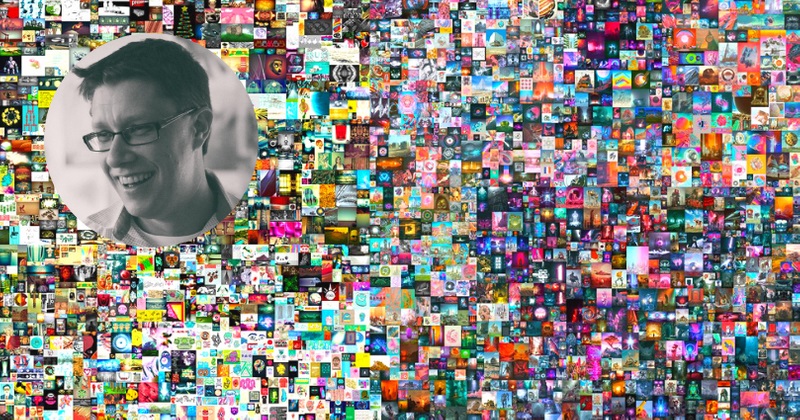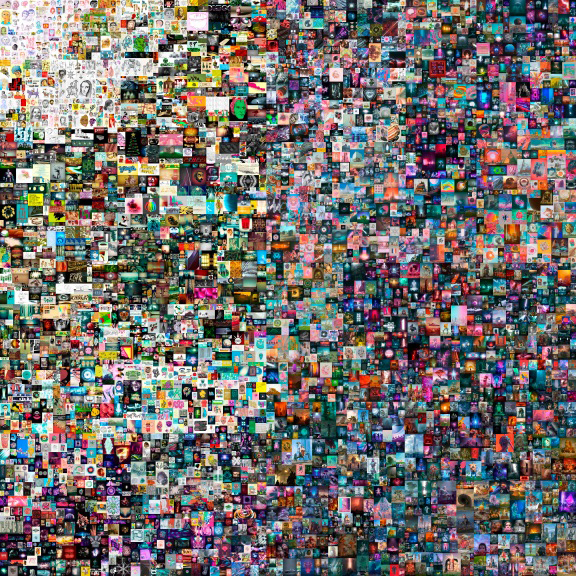
How Beeple sold his NFT for $69,000,000 (8 min read)
Beeple – a digital artist known also as Mike Winkelman who sold his work for $69 million on auction at Christie’s. That was the third most-expensive artwork sold by a living artist. It was „Everydays”, a set of 5,000 digital artworks documenting current news, sold as NFT (Non-Fungible Token).

Beeple History Timeline
- 2003 – Mike Winkelman uses the name „Beeple” for the first time to buy small stuffed animals called Beeples.
- May 1, 2007 – Beeple begins to create Everydays - a piece of digital art for every single day, commenting current news or portraying future visions
- 2010 – the first Beeple’s VJ Loops are uploaded to Vimeo, under CC license. They quickly get seen around the globe as all other DJs and VJs can use them in any form they want.
- 2018-2019 – Winkelman collaborated with Louis Vuitton and some of his Everydays were printed on the Spring/Summer collection
- Aug 22, 2019 – Joe Rogan reposted one of Beeple’s animations. It received over 4k reactions which means the reach must have been massive
- Oct 30, 2020 – Beeple begins to test his „salability” and launches his first three NFTs – „Politics is bullshit”, „Crypto is bullshit”, „Crossroad”.
- Dec 11 2020 – Winkelman held an auction of 10 pieces. Each sold for at least $100,000. Actually, $582,00 worth of his art has been sold in five minutes.
- Dec 12, 2020 – another 11 pieces were sold with „The Complete MF Collection” - a whole set of digital loops of every single piece sold that weekend. That went for $777,777 and artworks sold on these two days totalled at $3.5 million.
- Feb, 26 2021 – „Crossroads” got resold for over $6.6 million dollars
- Mar, 2021 – Everydays are sold on Christies for around $69 million

Who is Beeple?
Beeple is a digital artist. His true name is Mark Winkelman. His nickname comes from “Beeples” – small, stuffed toys he was buying. He comes from an ordinary, American family, but was successful thanks to his inner talent, stubbornness, and a bit of luck, of course.
Beeple VJ loops
Beeple made his name through releasing VJ Loops under CC license which means they could be used by anyone, in any form, for commercial and non-commercial purposes.
These works have been of such a high quality that they’ve been used almost too frequently by VJs around the world. There are even YouTube tutorials on how to start VJing based on Beeple’s VJ Loops.
That also has set the career of Beeple - he worked with Apple and Louis Vuitton, created visuals for Super Bowl, and landed many other commercial collaborations.

Social following
Publishing provocative loops daily for over 13 years has brought over 2 million fans to Beeple. That was enough to put his name on the radar and also was a potential to monetize. Winkelman saw other artists selling art as NFTs for high amounts and thought that with his following, he could make even more.
Beeple – Everydays: The First 5000 days
The set of 5,000 digital art pieces was completed on 21st February 2021, and it got sold for $69,3 million at Christie's art gallery. It was titled Everydays: The First 5000 Days. It's said to be the most expensive NFT by a living artist.

The collage consists of five thousand works that Beeple was creating day by day, for 5,000 days in a row. The price comes from the high quality of those works (and the whole collage, too), and the fact that they were all handmade. Some images have been drawn manually by Beeple, without the use of a computer.
Beeple – “Politics is bullshit”
When Beeple first heard of the NFTs, he wanted to test the market and created 100 NFTs called „Politics is BullShit" and sold them for $1 each (they were later changing hands for six figures). Then, he created two scarce NFTs minted in one unit each. Those went for $66,666 and then a set of select Everydays got sold for $3,5 million. That was enough to say the whole Everydays collection could go for an astronomic amount.
Regular posting
Regular, consistent posting is often the key to success on social media. The more you post (preserving quality), the more reach you get which gives you more chances at growing your audience.
It’s hard to post everyday for a year, not to mention to create for over 13 years, but as Beeple mentioned in one of the interviews - once you create momentum, it’s harder to stop.

Taking the unpaved path
Most young artists try to make their name through art galleries where some of them eventually make it to curated collections. This way, they can work for their names steadily, but if they have what it takes, they can get it (along with some luck and networking, perhaps).
But Beeple? He took the wild road which fits his style perfectly. He hopped on to an unregulated, P2P market of NFT and crypto. It had been sold by Christie’s, one of the oldest auction houses on earth that operates for two centuries, but the form of it allowed for enough speculation.
Timing
Beeple has had so much luck with the timing of his work. It was when NFTs were extremely hyped, and the whole crypto space continued a bull run, reaching all-time-high prices consequently. Such industry moods encouraged to invest more in the crypto space as it was likely to return quickly.

Storytelling
People are attracted by stories and better remember them. That also refers to visual storytelling and every piece of Beeple’s art showcases another story from current news or portraying a vision for the future.
The Authenticity Effect
People fall for authentic, more human brands, also personal brands. Beeple has a lowbrow sensibility and an outsider’s position in the world of art which makes his work more attractive to a wider audience – hence 2 million followers on Instagram.
Underdog Effect
There is an effect that makes people to support those who are expected to lose against established powers. Beeple, as a perceived outsider playing against traditional art galleries or critics, is a more engaging story than hearing about another artist acclaimed by the hermetic art community.
Labor Illusion
Complimentary ot the Underdog Effect, Beeple’s story documented through Everydays on a daily basis creates labor illusion – the audience follows him on his journey that is quite different to that of people’s in the art environment.
Scarcity
Scarcity, an opportunity to own something unique, increases the perceived value of an item and justifies spending more on it. That could be the case of the final price of Everydays.
FOMO
Every spectacular bull run (markets moving up), creates the fear of missing out – investors want to join the trend while it’s not too late to cash in on returns. That fuels further upwards price movements and encourages to look for next ‘big’ investments that might have gone unnoticed. Both of these aspects could have a play in this case.

If there’s one thing that we can learn from this case is being consistent at what you’re doing. Of course, his style evolved over the years, but he kept working for 13 years before the NFT craze allowed him to sell his artworks for over $72 million in total and earn 10% for every future resale.
Keep working on your product and your time will come. Still - along the way, you’re quite likely to build a solid following while documenting your journey.
Devour your competition
with the wittiest Marketing there is!
- viral marketing case studies that made over $880M within months
- cognitive biases in marketing to influence your customers minds
- growth hacks to double your conversion within a week
*$0 to $30M in 9 weeks case study in the first email